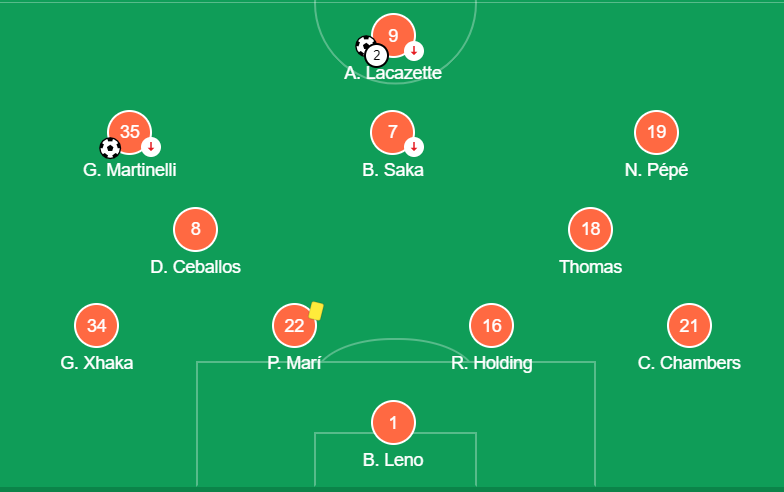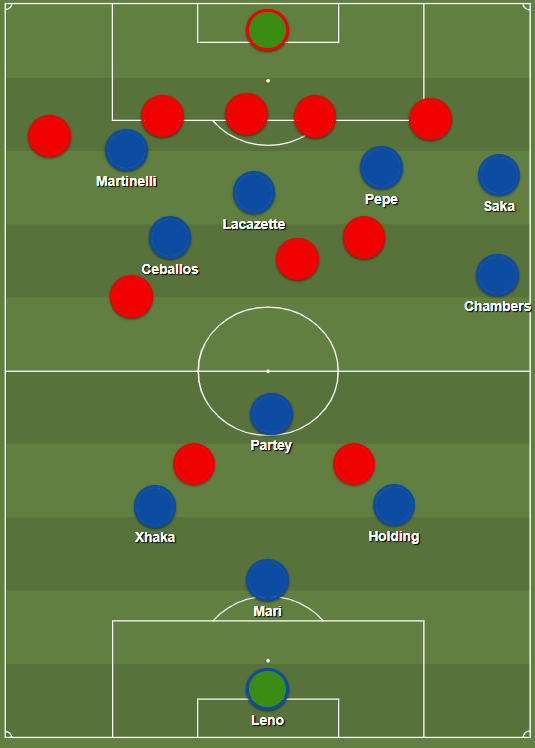Match Report: How Arsenal were able to put Sheffield United to the sword
With Arsenal’s injury list growing bigger by the day, Arsenal found themselves without a natural attacking midfielder or left back in the side. Mikel Arteta decided to play an unusual 3-1-6 to remove the need for a natural left back or number 10 which paid dividends for his side as they were able to hold a 1-0 advantage going into half time (which can also be put down to the quality of the opposition.) Then they reverted to their ‘natural formation,’ the 4-2-3-1 to see out the game, scoring 2 more goals in the process helped by the brilliance of Nico Pépé & Thomas Partey.
Line up:
Arsenal played a 3-1-6 in the entirety of the first half with Thomas Partey being tasked to hold down the midfield on his own with the front 6 of Arsenal looking to outnumber the Sheffield United back 5 when they had the ball. This strategy worked well for Arsenal with them getting 60% of the possession in this half and getting 8 shots on goal. The inferiority of Sheffield United was on show in this half as they were able to only get 2 shots on goal & they completed over 100 passes less than Arsenal.
The second half was more about seeing the game out for Arsenal, even though they were able to score 2 great goals. Arsenal & Sheffield United both shared possession (50% each) with Arsenal marginally getting more shots on goal (6). They went to their 4-2-3-1 shape with Calum Chambers completing his defensive duties instead of him being an extra attacker (but he was still there when Arsenal were on counters.)
In Defence:
First Half
When Arsenal defended an early attack by Sheffield United, the defenders relied on the links, Holding-Mari & Chambers-Xhaka to attain control centrally (something Mikel Arteta constantly looks to do with his side. The proximity between the defenders & the forward (Pépé) should allow Arsenal to quickly transition from defence to attack once Sheffield United inevitably loses the ball, giving Arsenal control of the game & a way out from Sheffield United’s high press, which doesn’t happen here.
Another reason as to why Arsenal opted to use a 2-2 instead of a back 4 is because of Sheffield United’s main threat coming from the middle as opposed to out wide (as is the case with every single Premier League side that isn’t them) so higher numbers of central defenders will stop McGoldrick from being able to get a good shot on goal once he is picked out.
Arsenal deploys a man-marking approach to defending here with all but 1 player having a player to keep a lookout for. Despite his runner being in his blind spot, Granit Xhaka was able to block space to take the sting out of McGoldrick's contention for the header with Pablo Mari, which in turn lessened the passing options that could get the ball as a result.
The task of the vacant man is to go deeper & win the ball from different scenarios, especially as Sheffield United have only committed 4 men in attack & Arsenal have 5-7 men ready to pounce on the opposition when the chance arises.
Second Half
Arsenal defended with a back 5 for a lot of the second half with Gabriel Martinelli dropping deeper where the LB/LWB would be situated to give Arsenal a defensive numerical advantage and to allow both CB’s to keep an eye out on the man ready to take a shot on goal if the ball falls to him.
Arsenal would be partially weaker when they attack from this position as they would be a man short in attack (Martinelli would have to cover a lot of ground to get to the right position,) but the positives of having your LW drop into the LWB/LB spot outweigh the negatives of it.
Arsenal continues to man-mark with Sheffield United committing 8 men forward. Dani Ceballos was able to tackle from that position & nothing malicious came out of it, but the recurrence of the man-marking shows that it’s a systemic demand instead of something done as a result of circumstance (which is what happens a lot of the time when a team is tasked with defending a slender advantage.)
Arsenal were able to defend this way as they have 3 outlets in the side (Willian, Pépé & Martinelli) so if they do get away with the ball on the break, they’re able to run into space & pounce on the 3 men Sheffield United have back ready to stop this situation altogether.
On Transition:
First Half
The Bukayo Saka-Nico Pépé dynamic was a big part of how Arsenal attacked in the first half, especially when they hit Sheffield United on the counter & their intelligence (in comparison to the Sheffield United players) created openings & exploited a lot of gaps that were in the system due to their LWB being too high up the pitch.
Nico Pépé was situated in his ‘preferred’ role as an inverted winger, with Bukayo Saka providing the width so he has extra space to run into & Lacazette squeezed behind the Sheffield United CB so they have someone else to worry about as well as Nico Pépé.
Arsenal countered in a 4-5-1 with Alex Lacazette taking up an LCM role to allow Nico Pépé to advance forwards. They squeezed together defensively as there wasn’t much threat from Sheffield United out wide, and Bukayo Saka is more than good enough at defending wide spaces.
When Arsenal countered, they looked to target the Sheffield United wide centre-backs instead of the central one as the wide ones were more rash & were more likely to concede fouls when ran at (Enda Stevens conceded 2 fouls during the game.)
Arsenal built in a 2-3-5 with Rob Holding (not in the picture) being situated out wide as there was an overload by Sheffield United in case Arsenal lost the ball. Arsenal built in a 2-3-5 as Sheffield United had bad attackers, and having the extra man in midfield makes sense due to the extent to which Arsenal controlled the game. Granit Xhaka slots into the LCM position as there’s more space for him to spray out the ball, either switching play to Saka/Pépé or playing the ball over to Alex Lacazette. Partey takes up the RCM spot as he’s able to evade the 2 men looking to press him when he receives the ball & Ceballos is situated as the deepest player as there is room for him to progress the ball when he gets it.
Second Half:
On the rare occasion, Arsenal did attempt a counter on Sheffield United, the Pépé/Chambers dynamic was key for Arsenal's progression. Chambers was progressing from the inside after receiving the ball from Dani Ceballos with Pépé venturing on the outside before Chambers went on Pépé's outside after he passed it to him.
The interchanging results in a 2 on 2 situation out wide between Chambers, Pépé & the Sheffield United players which is of benefit to Arsenal as Pépé can attempt more take ons (which is his bread & butter) and he can receive adequate support from Chambers who can stay overlapping him or can underlap when/if needed.
In Attack:
First Half
In the first half, Arsenal attacked the 5-3-2 of Sheffield United in an unconventional 3-1-6 shape. The purpose of this shape is to allow as many men forward as possible to overload the opposition in the Buildup phase. This was a successful approach, especially during Arsenal’s first goal when they had 6 men in the 18-yard box (matching the 6 men Sheffield United had) dominating them through quality & technical ability alone. The isolation of Thomas Partey as the single CM put the onus on him to connect defence & attack, which he did well (he recorded 4 Shot Creating-Actions & 2 Goal Creating-Actions as a result.)
Arsenal’s overloads in the first half can be shown by how they were able to approach their counterattacks. Arsenal preferred to counter on the right-hand side, committing 4 runners there which resulted in Sheffield United defending with 7 men on Arsenal’s right-hand side. They got around this with Lacazette switching the play onto open space for Martinelli to chase down & get a shot across as a result.
As Sheffield United are individually weak, they try to compensate by overloading sides where the opposition attack to contain their attacks. Lacazette was used as a linkman between the RHS & LHS to counter this & Sheffield United had no answer to that.
For Alex Lacazette’s goal, Arsenal created a 6v6/8 situation in the opposition box relying on their players being better than the opposition to score. Lacazette, Saka & Ceballos linked up well together to get past the Sheffield United central overload with Lacazette slotting it home after.
I need to note that this is reproducible only if Arsenal are playing a team that’s technically weaker than them or worse than them man for man. It won’t work against the top 6 sides unless there are systemic flaws with the opposition (so they commit too few men) or if Arsenal have players that are simply too good for the opposition to defend.
Second Half
Gabriel Martinelli’s goal came about with Nicolas Pépé being able to take on a few Sheffield United players & for Martinelli to slot in the rebound. The distance between the circled space and the Sheffield United players (that are boxed) shows one of their biggest weaknesses, especially since Chris Wilder left them. They lack defensive cohesion, with their RWB being caught ball-watching & failing to track Gabriel Martinelli’s run as a result of it.
This goal exposed the deficiencies in the Sheffield United setup. Thomas Partey was able to get the ball through 3 Sheffield United players onto the path of Alex Lacazette who was able to slot it home first time.
A team capable of holding their defensive shape won't concede such a chance, even if it was so late on in the game as they would be more alert & better equipped to stop it.
Problems with this system:
Arsenal's midfield is susceptible to being overrun as no midfielder can hold off the very best on his own.
Arsenal can't utilise Aubameyang in this setup as he's a high-risk player (he loses the ball in valuable areas resulting in Arsenal being done on transition as they lack the numbers in midfield to withstand pressure.)
They still leave big gaps when defending in the 2 banks of 2 which will be exploited by a good between the lines attacker.
Last Thoughts
This system is great for certain games if you have the perfect midfielder to connect defence & attack (which Arsenal have with Partey.) Sheffield United were the perfect team to experiment with the 3-1-6 against as they have no transitional threat & they rely on opposition mistakes to fashion out chances (which lessens with Thomas Partey on the pitch, Granit Xhaka sitting deeper & Dani Ceballos nowhere near the midfield to lose the ball.) Against better opposition, Arsenal would be better suited to sticking with the 3-2-5 unless they sign players that are good enough to hold their own in the 3-1-6 which has a few standalone issues as it is (which I state in the preceding paragraph.)
Written by Harry (@RunReissRun on Twitter)














